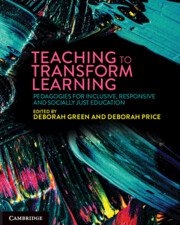Book contents
- Teaching to Transform Learning
- Acknowledgement of Country
- Teaching to Transform Learning
- Copyright page
- Contents
- Contributors
- Acknowledgements
- Introduction Understanding the learner to inform educators’ implementation of pedagogical approaches to transform learning
- Part 1 Pedagogies for all
- Part 2 Engaging pedagogies: making the curriculum come alive for all learners
- Part 3 Empowering pedagogies: 21st-century skill development and 22nd-century futures thinking
- 15 Understanding the world through transdisciplinary inquiry
- 16 Citizenship education: a relational approach
- 17 Flipping constructivist pedagogies to enable the equal intensity of depth and breadth in learning
- Index
- References
17 - Flipping constructivist pedagogies to enable the equal intensity of depth and breadth in learning
from Part 3 - Empowering pedagogies: 21st-century skill development and 22nd-century futures thinking
Published online by Cambridge University Press: 25 October 2024
- Teaching to Transform Learning
- Acknowledgement of Country
- Teaching to Transform Learning
- Copyright page
- Contents
- Contributors
- Acknowledgements
- Introduction Understanding the learner to inform educators’ implementation of pedagogical approaches to transform learning
- Part 1 Pedagogies for all
- Part 2 Engaging pedagogies: making the curriculum come alive for all learners
- Part 3 Empowering pedagogies: 21st-century skill development and 22nd-century futures thinking
- 15 Understanding the world through transdisciplinary inquiry
- 16 Citizenship education: a relational approach
- 17 Flipping constructivist pedagogies to enable the equal intensity of depth and breadth in learning
- Index
- References
Summary
In this chapter, we will inquire into a common definition of constructivism that acknowledges cognition (learning) not as a passive process of receiving information, but as an active process of making meaning, a mental construction that reframes our existing understandings from our different experiences (Olusegun, 2015). In addition, we will explore the historical roots of constructivism to identify common themes in these models through examining insights from key theorists, its strengths and possible limitations. Furthermore we will present a rationale for a ‘flipped PBL’ constructivist pedagogy that provides learners with discourse through authentic problems that enable situational and ongoing cognitive motivation by way of mastery of key concepts and the application of conceptual knowledge to a range of contexts. The uniqueness of this pedagogical approach employs flipped learning experiences to build expertise, depth of learning and problem-solving across a range of contexts to ensure breadth of application. To gain a deeper understanding of this approach, we will also look at some examples of its application in a primary and secondary context and examine the implications for its use.
Keywords
- Type
- Chapter
- Information
- Teaching to Transform LearningPedagogies for Inclusive, Responsive and Socially Just Education, pp. 272 - 287Publisher: Cambridge University PressPrint publication year: 2024

